Adaptation of Cascade Hydropower Station Scheduling on A Headwater Stream of the Yangtze River under Changing Climate Conditions
Abstract
:1. Introduction
2. Rainfall Discharge Modeling over the Jinsha River Basin
2.1. Overview of the Study Region and Data Collection
2.2. Weather Stations’ Rainfall Collinearity Inspection
2.3. Rainfall–Discharge Multivariate Linear Regression Modeling
2.4. Validation of Jinsha Rainfall–Discharge Statistical Model
3. Inflow Trend Analysis of Jinsha River under Climate Change
3.1. Climate Change Simulation over Jinsha River Basin
3.2. Inflow Trend Analysis of Jinsha River
3.3. Hydrological Frequency Analysis for Jinsha River
4. Adaptation of Cascade Hydropower Stations’ Scheduling on Jinsha River under Changing Climate Conditions
5. Conclusions
Acknowledgments
Author Contributions
Conflicts of Interest
References
- Wang, C.; Zhou, J.P.; Lu, P.; Yuan, L. Long-term scheduling of large cascade hydropower stations in Jinsha River, China. Energy Convers. Manag. 2015, 90, 476–487. [Google Scholar] [CrossRef]
- Jeroen, C.J.H.A.; Wouter, B.W.J. Climate change impacts on pricing long-term flood insurance: A comprehensive study for the Netherlands. Glob. Environ. Chang. 2011, 21, 1045–1060. [Google Scholar]
- Majone, B.; Villa, F.; Deidda, R.; Bellin, A. Impact of climate change and water use policies on hydropower potential in the south-eastern Alpine region. Sci. Total Environ. 2016, 543, 965–980. [Google Scholar] [CrossRef] [PubMed]
- Vezzoli, R.; Mercogliano, P.; Pecora, S.; Zollo, A.L.; Cacciamani, C. Hydrological simulation of Po River (North Italy) discharge under climate change scenarios using the RCM COSMO-CLM. Sci. Total Environ. 2015, 521–522, 346–358. [Google Scholar] [CrossRef] [PubMed]
- Lu, D.; Wang, B.; Wang, Y.; Zhou, H.; Liang, Q.; Peng, Y.; Roskilly, T. Optimal operation of cascade hydropower stations using hydrogen as storage medium. Appl. Energy 2015, 137, 56–63. [Google Scholar] [CrossRef]
- Lu, P.; Zhou, J.; Wang, C.; Qiao, Q.; Mo, L. Short-term hydro generation scheduling of Xiluodu and Xiangjiaba cascade hydropower stations using improved binary-real coded bee colony optimization algorithm. Energy Convers. Manag. 2015, 91, 19–31. [Google Scholar] [CrossRef]
- Ma, C.; Lian, J.J.; Wang, J. Short-term optimal operation of Three-Gorge and Gezhouba cascade hydropower stations in non-flood season with operation rules from data mining. Energy Convers. Manag. 2013, 65, 616–627. [Google Scholar] [CrossRef]
- Li, C.; Zhou, J.Z.; Shuo, O.Y.; Ding, X.; Chen, L. Improved decomposition–coordination and discrete differential dynamic programming for optimization of large-scale hydropower system. Energy Convers. Manag. 2014, 84, 363–373. [Google Scholar] [CrossRef]
- Mu, J.; Ma, C.; Zhao, J.Q.; Lian, J.J. Optimal operation rules of Three-gorge and Gezhouba cascade hydropower stations in flood season. Energy Convers. Manag. 2015, 96, 159–174. [Google Scholar] [CrossRef]
- Jiang, Z.; Ji, C.; Sun, P.; Wang, L.P.; Zhang, Y.K. Total output operation chart optimization of cascade reservoirs and its application. Energy Convers. Manag. 2014, 88, 296–306. [Google Scholar] [CrossRef]
- Li, X.; Wei, J.H.; Li, T.J.; Wang, G.Q.; Yeh, W.W.G. A parallel dynamic programming algorithm for multi-reservoir system optimization. Adv. Water Resour. 2014, 67, 1–15. [Google Scholar] [CrossRef]
- Yang, G.; Weng, L.; Li, L. Yangtze Conservation and Development Report 2007; Science Press: Beijing, China, 2008. [Google Scholar]
- Li, Y.; Guo, S.; Guo, J.; Wang, Y.; Li, T.; Chen, J. Deriving the optimal refill rule for multi-purpose reservoir considering flood control risk. J. Hydro-Environ. Res. 2014, 8, 248–259. [Google Scholar] [CrossRef]
- Lund, J.R.; Guzman, J. Derived operating rules for reservoirs in series or in parallel. J. Water Resour. Plan. Manag. 1999, 125, 143–153. [Google Scholar] [CrossRef]
- Wei, C.-C.; Hsu, N.S. Optimal tree-based release rules for real-time flood control operations on a multipurpose multireservoir system. J. Hydrol. 2009, 365, 213–224. [Google Scholar] [CrossRef]
- Chou, F.N.F.; Wu, C.W. Stage-wise optimizing operating rules for flood control in a multi-purpose reservoir. J. Hydrol. 2015, 521, 245–260. [Google Scholar] [CrossRef]
- Chaleeraktrakoon, C.; Chinsomboon, Y. Dynamic rule curves for flood control of a multipurpose dam. J. Hydro-Environ. Res. 2015, 9, 133–144. [Google Scholar] [CrossRef]
- Peugeot, C.; Cappelaere, B.; Vieux, B.E.; Seguis, L.; Maia, A. Hydrologic process simulation of a semiarid, endoreic catchment in Sahelian West Niger. 1. Model-aided data analysis and screening. J. Hydrol. 2003, 279, 224–243. [Google Scholar] [CrossRef]
- Wang, Y.; Liao, W.; Ding, Y.; Wang, X.; Jiang, Y.; Song, X.; Lei, X. Water resource spatiotemporal pattern evaluation of the upstream Yangtze River corresponding to climate changes. Quat. Int. 2015, 380–381, 187–196. [Google Scholar] [CrossRef]
- Birkinshaw, S.J.; Guerreiro, S.B.; Nicholson, A.; Liang, Q.H.; Quinn, P.; Zhang, L.L.; He, B.; Yin, J.X.; Fowler, H.J. Climate Change Impacts on Yangtze River Discharge at the Three Gorges Dam. Hydrol. Earth Syst. 2017, 21, 1911–1927. [Google Scholar] [CrossRef]
- Long, D.; Yang, Y.; Wada, Y.; Hong, Y.; Liang, W.; Chen, Y.; Yong, B.; Hou, A.; Wei, J.; Chen, L. Deriving scaling factors using a global hydrological model to restore GRACE total water storage changes for China's Yangtze River Basin. Remote Sens. Environ. 2015, 168, 177–193. [Google Scholar] [CrossRef]
- Lai, X.; Jiang, J.; Liang, Q.; Huang, Q. Large-scale hydrodynamic modeling of the middle Yangtze River Basin with complex river–lake interactions. J. Hydrol. 2013, 492, 228–243. [Google Scholar] [CrossRef]
- Chen, J.; Wu, X.; Finlayson, B.L.; Webber, M.; Wei, T.; Li, M.; Chen, Z. Variability and trend in the hydrology of the Yangtze River, China: Annual precipitation and runoff. J. Hydrol. 2014, 513, 403–412. [Google Scholar] [CrossRef]
- Meng, C.Q.; Zhou, J.Z.; Tayyab, M.; Zhu, S.; Zhang, H.R. Integrating Artificial Neural Networks into the VIC Model for Rainfall-Runoff Modeling. Water 2016, 8, 407. [Google Scholar] [CrossRef]
- McMillan, H.; Freer, J.; Pappenberger, F.; Krueger, T.; Clark, M. Impacts of uncertain river flow data on rainfall-runoff model calibration and discharge predictions. Hydrol. Process. 2010, 24, 1270–1284. [Google Scholar] [CrossRef]
- Bao, A.M.; Liu, H.L.; Chen, X.; Pan, X.L. The effect of estimating areal rainfall using self-similarity topography method on the simulation accuracy of runoff prediction. Hydrol. Process. 2011, 25, 3506–3512. [Google Scholar] [CrossRef]
- Xiong, L.H.; Yu, K.X.; Zhang, H.G.; Zhang, L.P. Annual runoff change in the headstream of Yangtze River and its relation to precipitation and air temperature. Hydrol. Res. 2013, 44, 850–874. [Google Scholar] [CrossRef]
- Chen, Z.; Yu, L.Z.; Gupta, A. The Yangtze River: An introduction. Geomorphology 2001, 41, 1–248. [Google Scholar] [CrossRef]
- Du, J.; Shi, C.X.; Zhang, C.D. Modeling and analysis of effects of precipitation and vegetation coverage on runoff and sediment yield in Jinsha River Basin. Water Sci. Eng. 2013, 6, 44–58. [Google Scholar]
- The Yangtze River Waterway Administration. 2016. Available online: http://yu-zhu.vicp.net/ (accessed on 20 April 2017).
- Liu, R.X.; Kuang, J.; Gong, Q.; Hou, X.L. Principal component regression analysis with spss. Comput. Methods Programs Biomed. 2003, 71, 141–147. [Google Scholar] [CrossRef]
- National Meteorological Information Center. 2016. Available online: http://www.escience.gov.cn/metdata/page/index.html (accessed on 20 April 2017).
- Djebou, D.C.S. Integrated approach to assessing streamflow and precipitation alterations under environmental change: Application in the Niger River Basin. J. Hydrol. Reg. Stud. 2015, 4, 571–582. [Google Scholar] [CrossRef]
- Wang, H.; Saito, Y.; Zhang, Y.; Bi, N.; Sun, X.; Yang, Z. Recent changes of sediment flux to the western Pacific Ocean from major rivers in East and Southeast Asia. Earth-Sci. Rev. 2011, 108, 80–100. [Google Scholar] [CrossRef]
- Djebou, S.; Dagbegnon, C.; Singh, V.P. Impact of climate change on precipitation patterns: A comparative approach. Int. J. Climatol. 2016, 36, 3588–3606. [Google Scholar] [CrossRef]
- Sohoulande Djebou, D.C.; Singh, V.P. Impact of climate change on the hydrologic cycle and implications for society. Environ. Soc. Psychol. 2015, 1, 9–16. [Google Scholar]
- Liu, P.; Guo, S.; Li, W. Optimal design of seasonal flood control water levels for the Three Gorges Reservoir. IAHS Publ. 2008, 319, 270–278. [Google Scholar]
- Yun, R.; Singh, V.P. Multiple duration limited water level and dynamic limited water level for flood control, with implication on water supply. J. Hydrol. 2008, 354, 160–170. [Google Scholar] [CrossRef]
- Li, X.; Guo, S.; Liu, P.; Chen, G. Dynamic control of flood limiting water level for reservoir operation by considering inflow uncertainty. J. Hydrol. 2010, 391, 124–132. [Google Scholar] [CrossRef]
- Li, Y.; Zhou, J.; Zhang, Y.; Qin, H.; Liu, L. Novel multiobjective shuffled frog leaping algorithm with application to reservoir flood control operation. J. Water Resour. Plan. Manag. 2010, 136, 217–226. [Google Scholar] [CrossRef]
- Chou, F.N.F.; Wu, C.W. Reducing the impacts of flood-induced reservoir turbidity on a regional water supply system. Adv. Water Resour. 2010, 33, 146–157. [Google Scholar] [CrossRef]
- Liu, P.; Guo, S.; Xiong, L.; Li, W.; Zhang, H. Deriving reservoir refill operating rules by using the proposed DPNS model. Water Resour. Manag. 2006, 20, 337–357. [Google Scholar] [CrossRef]
- Zhou, J.Z.; Zhang, Y.C.; Zhang, R.; Shuo, O.Y.; Wang, X.M.; Liao, X. Integrated optimization of hydroelectric energy in the upper and middle Yangtze River. Renew. Sustain. Energy Rev. 2015, 45, 481–512. [Google Scholar] [CrossRef]
- Xie, M.F.; Zhou, J.Z.; Li, C.L.; Zhu, S. Long-term generation scheduling of Xiluodu and Xiangjiaba cascade hydro plants considering monthly streamflow forecasting error. Energy Convers. Manag. 2015, 105, 368–376. [Google Scholar] [CrossRef]
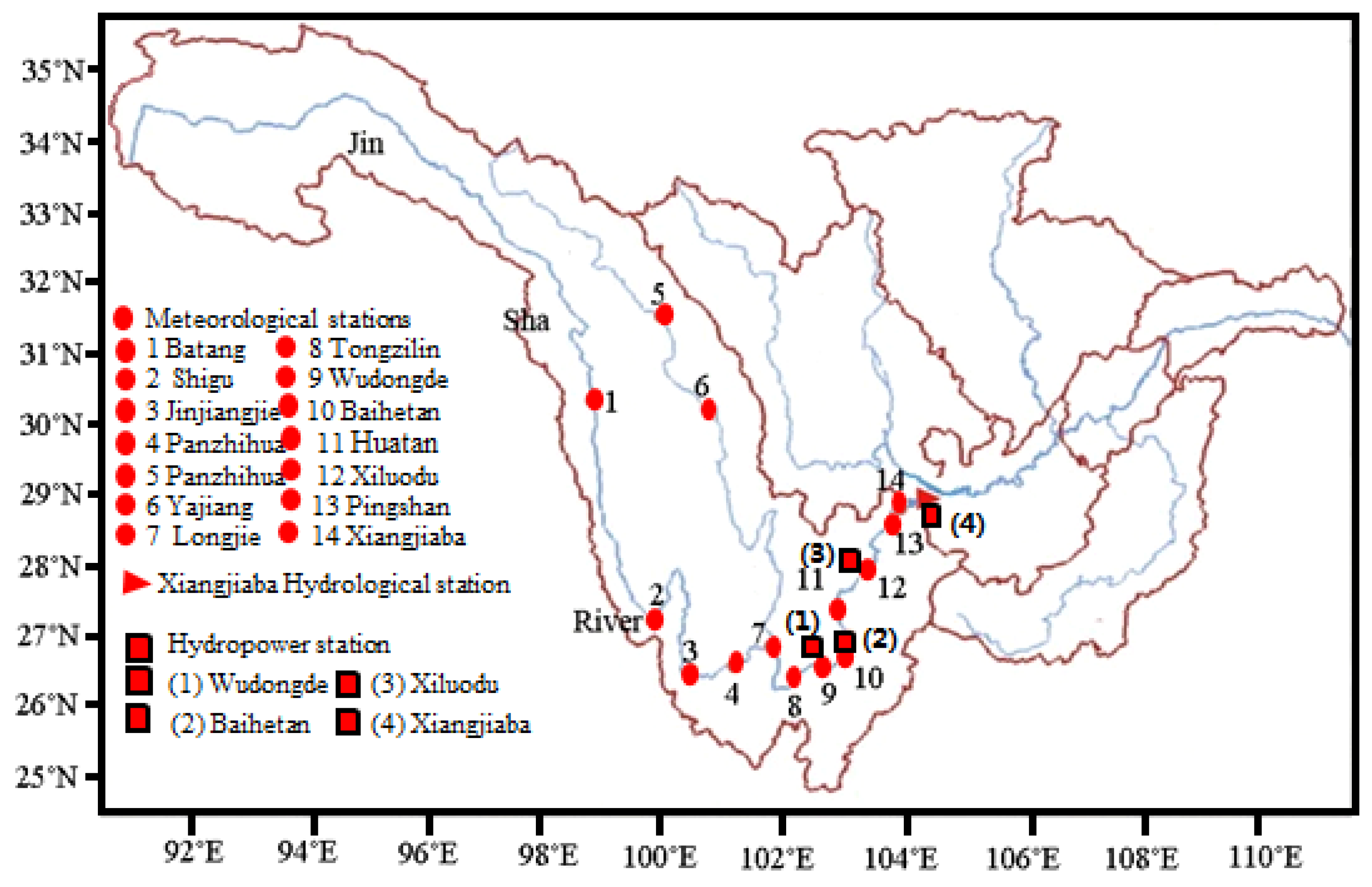
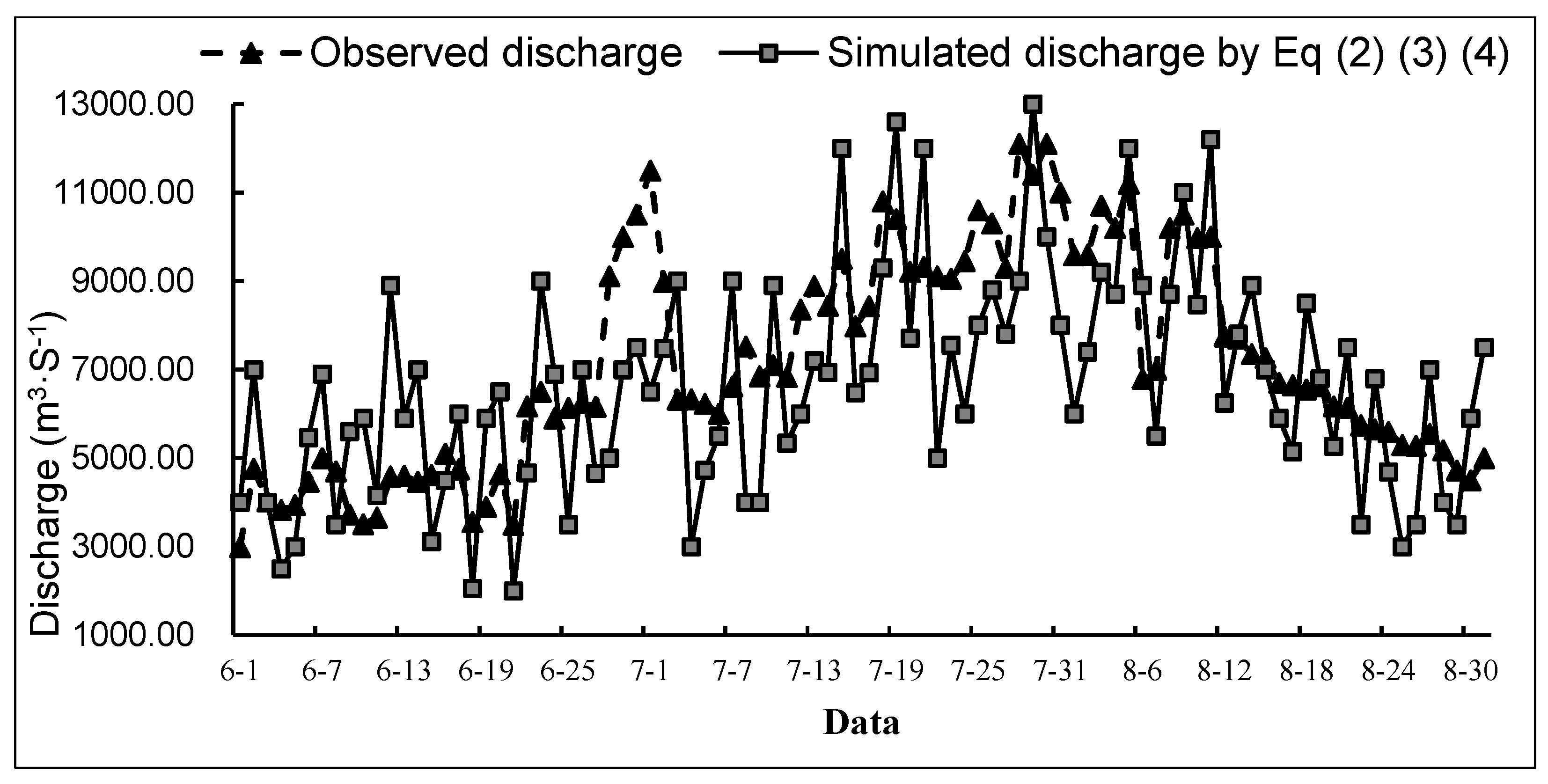
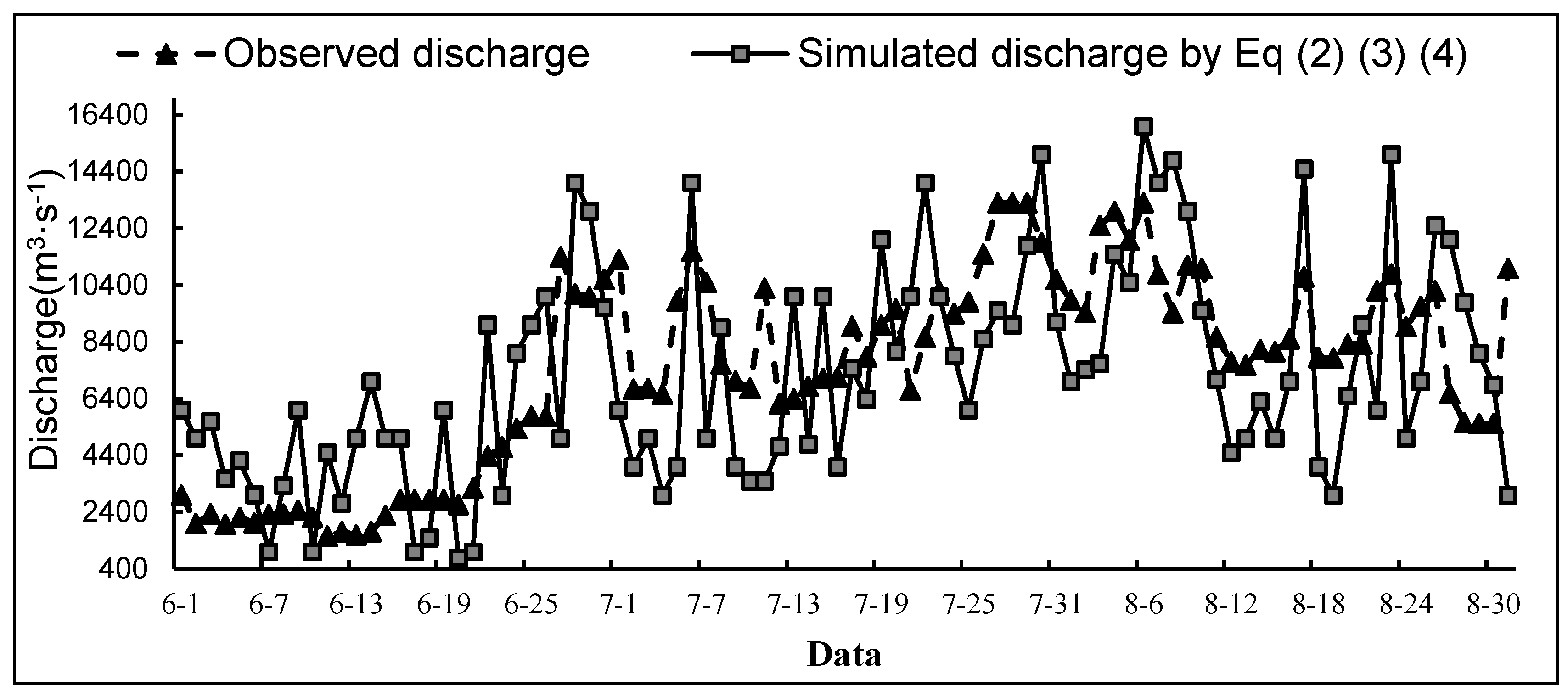
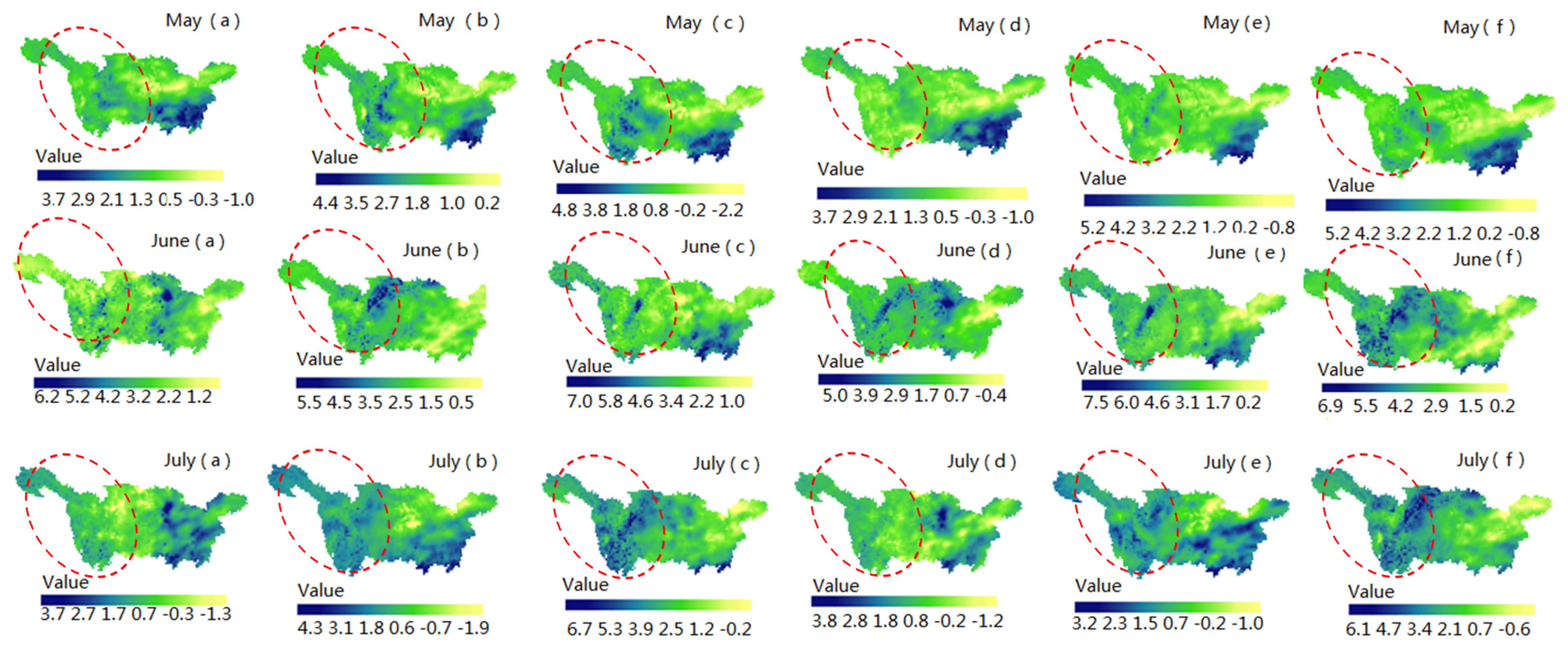
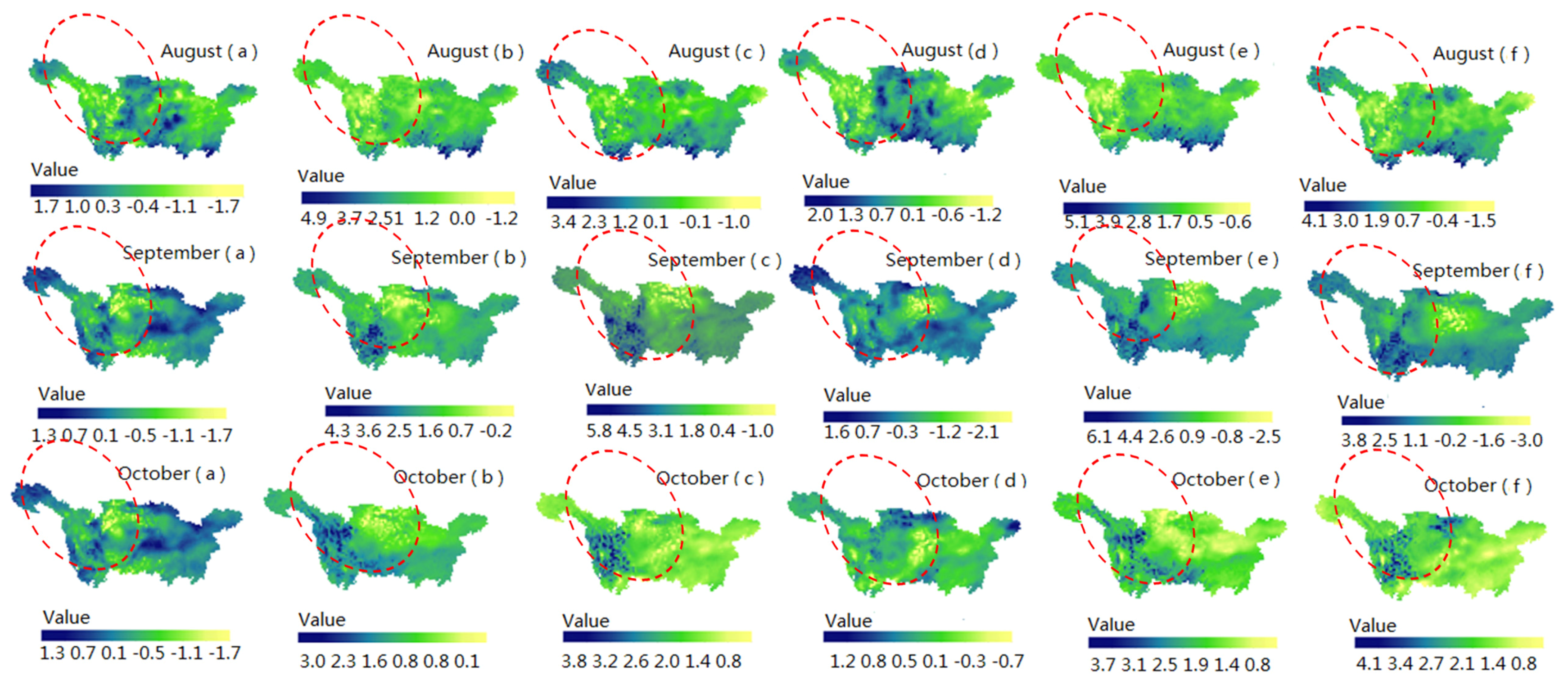

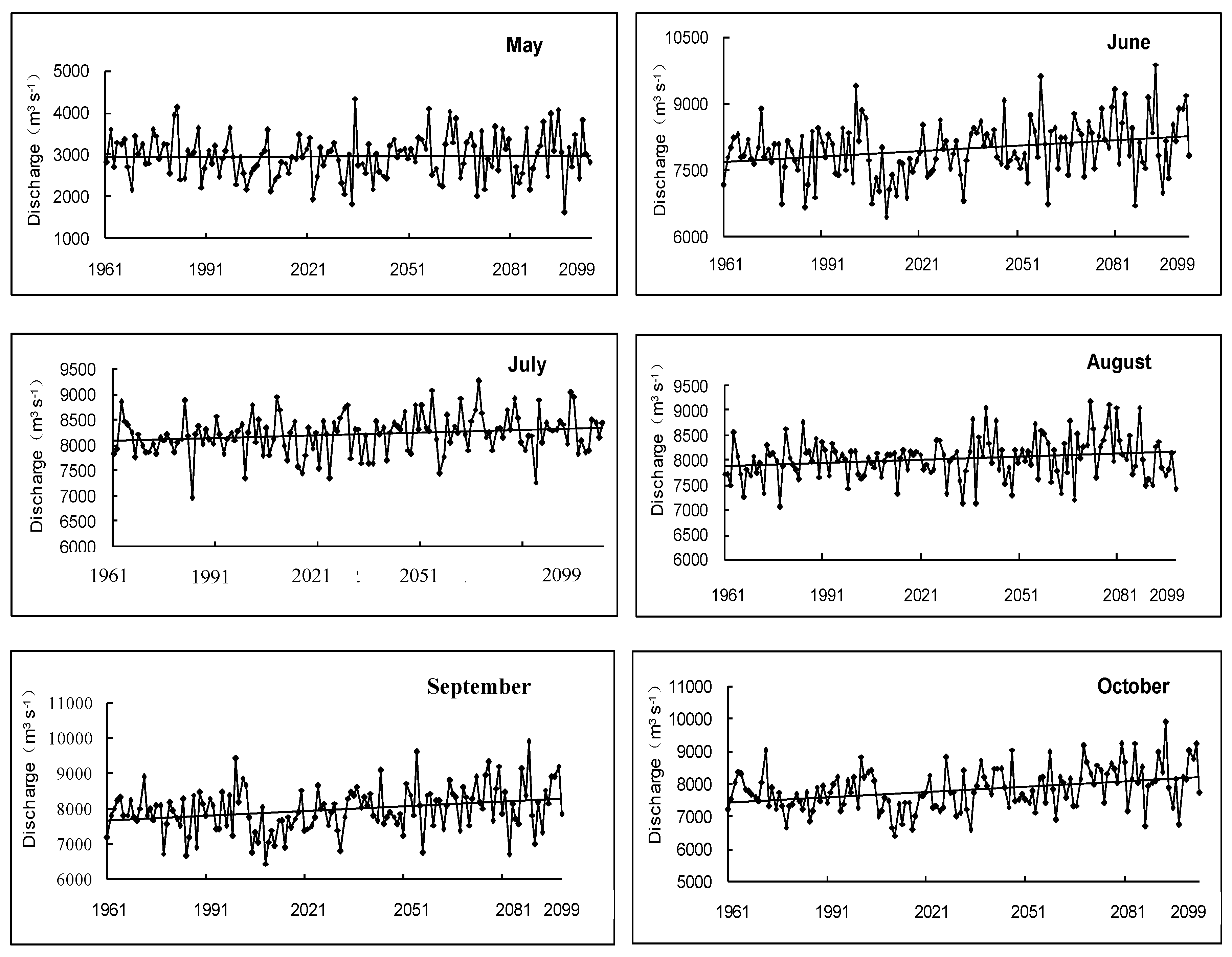

| Dimension | Eigenvalue | Conditional Index | Variance Proportion | ||||||||||||||
|---|---|---|---|---|---|---|---|---|---|---|---|---|---|---|---|---|---|
| Constant | Batang | Shigu | Jinjiangjie | Panzhihua | Tongzilin | Yajiang | Ganzi | Longjie | Wudongde | Huatan | Baihetan | Xiluodu | Pingshan | Xiangjiaba | |||
| 1 | 2.91 | 1.00 | 0.00 | 0.02 | 0.00 | 0.00 | 0.00 | 0.00 | 0.01 | 0.00 | 0.00 | 0.02 | 0.01 | 0.01 | 0.02 | 0.01 | 0.01 |
| 2 | 1.93 | 1.23 | 0.00 | 0.00 | 0.03 | 0.04 | 0.00 | 0.02 | 0.00 | 0.00 | 0.00 | 0.02 | 0.06 | 0.03 | 0.00 | 0.00 | 0.00 |
| 3 | 1.67 | 1.32 | 0.00 | 0.00 | 0.05 | 0.05 | 0.01 | 0.01 | 0.01 | 0.06 | 0.03 | 0.02 | 0.02 | 0.05 | 0.00 | 0.00 | 0.00 |
| 4 | 1.25 | 1.53 | 0.00 | 0.07 | 0.01 | 0.00 | 0.04 | 0.16 | 0.05 | 0.01 | 0.15 | 0.01 | 0.00 | 0.00 | 0.01 | 0.00 | 0.00 |
| 5 | 1.18 | 1.57 | 0.00 | 0.08 | 0.03 | 0.01 | 0.06 | 0.04 | 0.13 | 0.25 | 0.01 | 0.00 | 0.00 | 0.00 | 0.01 | 0.00 | 0.00 |
| 6 | 1.03 | 1.69 | 0.00 | 0.01 | 0.00 | 0.01 | 0.56 | 0.00 | 0.19 | 0.00 | 0.01 | 0.04 | 0.01 | 0.00 | 0.01 | 0.00 | 0.00 |
| 7 | 1.00 | 1.71 | 1.00 | 0.00 | 0.00 | 0.00 | 0.00 | 0.00 | 0.00 | 0.00 | 0.00 | 0.00 | 0.00 | 0.00 | 0.00 | 0.00 | 0.00 |
| 8 | 0.92 | 1.78 | 0.00 | 0.18 | 0.05 | 0.00 | 0.02 | 0.17 | 0.08 | 0.08 | 0.00 | 0.03 | 0.00 | 0.02 | 0.05 | 0.00 | 0.00 |
| 9 | 0.81 | 1.90 | 0.00 | 0.02 | 0.00 | 0.12 | 0.02 | 0.03 | 0.07 | 0.05 | 0.28 | 0.03 | 0.01 | 0.01 | 0.06 | 0.00 | 0.00 |
| 10 | 0.69 | 2.05 | 0.00 | 0.23 | 0.00 | 0.00 | 0.11 | 0.01 | 0.01 | 0.00 | 0.02 | 0.27 | 0.01 | 0.20 | 0.03 | 0.00 | 0.01 |
| 11 | 0.65 | 2.12 | 0.00 | 0.17 | 0.01 | 0.01 | 0.14 | 0.04 | 0.41 | 0.40 | 0.03 | 0.04 | 0.01 | 0.00 | 0.00 | 0.00 | 0.00 |
| 12 | 0.41 | 2.67 | 0.00 | 0.00 | 0.00 | 0.01 | 0.00 | 0.00 | 0.00 | 0.03 | 0.05 | 0.48 | 0.33 | 0.00 | 0.16 | 0.01 | 0.04 |
| 13 | 0.29 | 3.19 | 0.00 | 0.05 | 0.22 | 0.39 | 0.00 | 0.11 | 0.02 | 0.04 | 0.02 | 0.01 | 0.11 | 0.35 | 0.29 | 0.00 | 0.01 |
| 14 | 0.23 | 3.53 | 0.00 | 0.10 | 0.34 | 0.19 | 0.00 | 0.28 | 0.00 | 0.06 | 0.09 | 0.02 | 0.36 | 0.25 | 0.11 | 0.00 | 0.06 |
| 15 | 0.04 | 8.54 | 0.00 | 0.08 | 0.26 | 0.16 | 0.03 | 0.11 | 0.00 | 0.01 | 0.29 | 0.01 | 0.08 | 0.07 | 0.25 | 0.98 | 0.88 |
| Number | Input Variable | Remove Variable | Step-Wise Method |
|---|---|---|---|
| 1 | Wudongde | - | Step (criterion: F-to-enter probability ≤ 0.050; F-to-remove probability ≥ 0.1) |
| 2 | Longjie | - | Step (criterion: F-to-enter probability ≤ 0.050; F-to-remove probability ≥ 0.1) |
| 3 | Jinjiangjie | - | Step (criterion: F-to-enter probability ≤ 0.050; F-to-remove probability ≥ 0.1) |
| 4 | Shigu | - | Step (criterion: F-to-enter probability ≤ 0.050; F-to-remove probability ≥ 0.1) |
| 5 | Ganzi | - | Step (criterion: F-to-enter probability ≤ 0.050; F-to-remove probability ≥ 0.1) |
| 6 | Batang | - | Step (criterion: F-to-enter probability ≤ 0.050; F-to-remove probability ≥ 0.1) |
| 7 | Huatan | - | Step (criterion: F-to-enter probability ≤ 0.050; F-to-remove probability ≥ 0.1) |
| 8 | Pingshan | - | Step (criterion: F-to-enter probability ≤ 0.050; F-to-remove probability ≥ 0.1) |
| 9 | Xiangjiaba | - | Step (criterion: F-to-enter probability ≤ 0.050; F-to-remove probability ≥ 0.1) |
| 10 | Tongzilin | - | Step (criterion: F-to-enter probability ≤ 0.050; F-to-remove probability ≥ 0.1) |
| 11 | Xiluodu | - | Step (criterion: F-to-enter probability ≤ 0.050; F-to-remove probability ≥ 0.1) |
| 12 | Panzhihua | - | Step (criterion: F-to-enter probability ≤ 0.050; F-to-remove probability ≥ 0.1) |
| 13 | Baihetan | - | Step (criterion: F-to-enter probability ≤ 0.050; F-to-remove probability ≥ 0.1) |
| 14 | Yajiang | - | Step (criterion: F-to-enter probability ≤ 0.050; F-to-remove probability ≥ 0.1) |
| Model | R | R Square | Adjusted R | Standard Estimate Error | Sig. F | Correlation Coefficient |
|---|---|---|---|---|---|---|
| 1 | 0.845 | 0.714 | 0.682 | 677.738 | 0.007 | 0.717 |
| Variables | B | Standard Error | T | Sig. T |
|---|---|---|---|---|
| constant | 2983.378 | 121.262 | 24.603 | 0.000 |
| Batang | 120.279 | 17.003 | 7.074 | 0.000 |
| Shigu | −133.664 | 12.197 | −10.959 | 0.000 |
| Jinjiangjie | 108.082 | 11.307 | 9.558 | 0.000 |
| Panzhihua | −32.282 | 8.664 | −3.726 | 0.000 |
| Tongzilin | −48.243 | 8.945 | −5.393 | 0.000 |
| Yajiang | 23.760 | 8.695 | 2.733 | 0.007 |
| Ganzi | 73.090 | 10.971 | 6.662 | 0.000 |
| Longjie | 93.203 | 8.154 | 11.430 | 0.000 |
| Wudongde | 22.005 | 5.321 | 4.136 | 0.000 |
| Huatan | 46.549 | 7.164 | 6.498 | 0.000 |
| Baihetan | −16.696 | 6.984 | −2.391 | 0.018 |
| Xiluodu | 40.802 | 9.581 | 4.259 | 0.000 |
| Pingshan | −254.881 | 31.724 | −8.034 | 0.000 |
| Xiangjia | 161.600 | 25.342 | 6.377 | 0.000 |
| Recurrence intervals | 1961–1990 | 1991–2020 | 2021–2050 | 2051–2099 |
|---|---|---|---|---|
| May | ||||
| 100-year return period | 4187 | 3888 | 4117 | 4603 |
| 50-year return period | 4052 | 3748 | 3952 | 4387 |
| June | ||||
| 100-year return period | 5313 | 5509 | 5829 | 6161 |
| 50-year return period | 5167 | 5338 | 5648 | 5981 |
| July | ||||
| 100-year return period | 9054 | 9066 | 9152 | 9403 |
| 50-year return period | 8926 | 8951 | 9040 | 9254 |
| August | ||||
| 100-year return period | 8896 | 8599 | 9140 | 9389 |
| 50-year return period | 8773 | 8525 | 9000 | 9224 |
| September | ||||
| 100-year return period | 9060 | 9515 | 9161 | 9936 |
| 50-year return period | 8908 | 9267 | 8992 | 9721 |
| October | ||||
| 100-year return period | 8907 | 9045 | 9485 | 9848 |
| 50-year return period | 8721 | 8864 | 9223 | 9636 |
| Parameter | Wudongde | Baihetan | Xiluodu | Xiangjiaba |
|---|---|---|---|---|
| Adjustment ability | Annual | Annual | Annual | Season |
| Regulating storage (billion m3) | 2.60 | 10.40 | 6.46 | 0.90 |
| Installed capacity (MW) | 8700 | 14,000 | 13,860 | 6400 |
| Dead water level (m) | 945 | 765 | 540 | 370 |
| Flood limiting water level (m) | 952 | 785 | 560 | 370 |
| Normal storage water level (m) | 975 | 825 | 600 | 380 |
| Water level range (m) | [945, 975] | [765, 825] | [540, 600] | [370, 380] |
© 2017 by the authors. Licensee MDPI, Basel, Switzerland. This article is an open access article distributed under the terms and conditions of the Creative Commons Attribution (CC BY) license (http://creativecommons.org/licenses/by/4.0/).
Share and Cite
Zhai, M.Y.; Lin, Q.G.; Huang, G.H.; Zhu, L.; An, K.; Li, G.C.; Huang, Y.F. Adaptation of Cascade Hydropower Station Scheduling on A Headwater Stream of the Yangtze River under Changing Climate Conditions. Water 2017, 9, 293. https://doi.org/10.3390/w9040293
Zhai MY, Lin QG, Huang GH, Zhu L, An K, Li GC, Huang YF. Adaptation of Cascade Hydropower Station Scheduling on A Headwater Stream of the Yangtze River under Changing Climate Conditions. Water. 2017; 9(4):293. https://doi.org/10.3390/w9040293
Chicago/Turabian StyleZhai, Ming Yang, Qian Guo Lin, Guo He Huang, Le Zhu, Kai An, Gong Chen Li, and Yue Fei Huang. 2017. "Adaptation of Cascade Hydropower Station Scheduling on A Headwater Stream of the Yangtze River under Changing Climate Conditions" Water 9, no. 4: 293. https://doi.org/10.3390/w9040293





